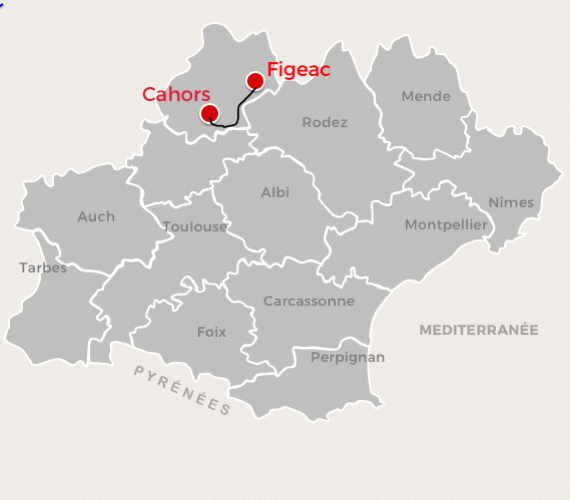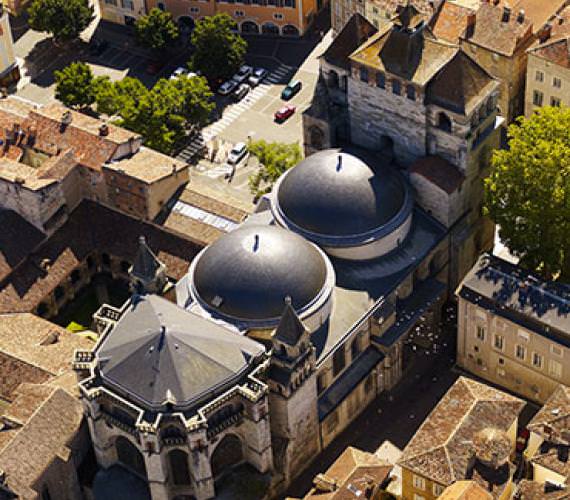

Features
Access by train
Go there by train with the Occitanie Rail Tour: Figeac, the starting point of this Fabulous Journey, is a stopover on the Bastides line and the Causses du Quercy line.
the best period
Spring and Autumn
duration
5 days
From Figeac, the pearl of the Célé valley, to Cahors, the city of Cadurques, this fabulous 5-day trip to Quercy invites you to follow in the footsteps of the pilgrims who, from the Middle Ages, converged on Saint-Jacques de Compostela. You will thus walk along some of the most beautiful sections of the GR®65 in Lot (the Via Podiensis known as Chemin du Puy). This legendary trail, promising enriching encounters and unusual discoveries, offers you the privilege of admiring the small emblematic heritage of the Causse while walking on a route classified as a World Heritage Site by UNESCO.

Don't set off before taking the time to visit Figeac, a town with an exceptional harmony! Start at the top on the Puy terraces for a great view over the town. Then go down to see all this flourishing market town has to offer.
Figeac has managed to preserve its heritage. Just look at the urban palaces and town houses from the Middle Ages, the medieval boutiques and "soleilhos", the open barns where fruit was dried. Next to Place des Ecritures is the World Writings Museum, in the house where Champollion, the most famous French Egyptologist, was born.

Figeac, @laura_dvy

Place des écritures à Figeac, ©D.Verneuil / Lot Tourisme
Equipped with your backpack proudly decorated with a scallop shell (sign of recognition for pilgrims), and equipped with your picnic, it is now time to leave your mark on the legendary route to Santiago de Compostela and participate, in your turn, in this beautiful human adventure already more than 1000 years old. To do this, you should first locate the GR®65 along the Célé: it is identifiable by its red and white markings. Let's go for a 20 kilometer stage!
The route (the longest stage on the trail) leads to Cajarc across the plateau separating the Célé and Lot valleys. After Faycelles, then Béduer, the landscape changes. You pass by menhirs, dolmens and charming dry-stone buildingson the way to Gréalou (374m), at the southern tip of the Causses du Quercy regional park.

Pèlerin sur le chemin de St Jacques de Compostelle, ©C.Ory / Lot Tourisme

Dolmen de Pech Laglaire à Gréalou, ©C.Novello / Lot Tourisme
We really recommend taking a look at the three Gréalou dolmens in the locality of Pech Laglayre. The stones stand 200 metres apart. You will need to look for the first one, but you can't miss the second, alongside the trail. The third dolmen is easy to find, but it is in poor condition. Pech Laglayre is at an altitude of 395 metres, with a 360° view. The 30-km stage can be shortened to 25 km if you spend the night in St Chels instead of Cajarc.
A 17 km stage (22 km if you set off from St Chels). You leave the south of Cajarc and cross the marsh plain in a bend of the River Lot. Next comes the climb towards the Causse de Limogne and the typical dry-stone cabins. The cabins are known as cazelles, gariottes or bories, depending on the region. They are no more than two centuries old. The stones to build them were found on the surface of nearby farmland.
These impressive cabins were made without mortar or framework. Quite an achievement! They were used as shelters by shepherds in bad weather and for storing farm tools. And you will probably enjoy a short break here, too.
At the end of the day, you arrive in the lovely village of Limogne, a lively town with plenty of shops. Ideal for stocking up on supplies!

Cazelle sur le causse de Limogne, ©C.Novello / Lot Tourisme
The day's trail runs for about 25 km and includes the picturesque villages of Varaire, Vaylats and Bach. In the first village, take a look at the washing place.
Today the washerwomen's gossip and soapy water have been replaced by the sound of fresh, running water, but the region's well-preserved washing places are still there. Some washing places have special V-shaped flagstones. They are charmingly known as "butterfly washing places". This is the case of the one in Varaire.
In Vaylats the impressive Convent of the Daughters of Jesus has made the village's reputation. In Bach, the disused phosphate quarry is open to visitors from April to November.

Lavoir à Varaire, ©C.Novello / Lot Tourisme

Lavoir à Varaire, ©C.Novello / Lot Tourisme
In Bach, once is not customary, it is in the restaurant that we advise you to recharge your batteries in order to break the routine of the – although so pleasant – picnic. So open the door to the Auberge Lou Bourdié where Julie and Monique will delight you with their traditional family cuisine (stuffed chicken, pig's trotters with saffron, "coutchat", Quercy lamb, pastis, etc.) for a great moment of happiness and of simplicity to share, of course, with a glass of Cahors-Malbec wine in hand!
As for Lalbenque, it is the undisputed capital of the black truffle of Quercy. Its market which takes place on Tuesdays from December to March is very famous.

After a good day of walking, it is one of the moments that we wait for with desire and curiosity.
This moment when you take off your shoes, this moment when you refresh yourself and relax... suddenly these simple moments have a special flavor.
At the Poudally lodge in Lalbenque, Elsa understands this well and she takes great care to welcome her hikers. Here the foot bath with essential oils is worth the detour in itself. To regain your strength for the next day, there is nothing like the friendly and tasty meal that she will have prepared followed by a good night's sleep in the dormitory or guest room accommodation.

Gîte d'étape de Poudally à Lalbenque, ©Poudally / Lot Tourisme
Did you know?
"Randos-Etapes du Lot": this label is given for accommodation respecting a charter including a high-quality welcome and services adapted to hikers.
Accommodation includes stopover gîtes, guest rooms, hotels or any other kind of accommodation meeting precise specifications. They are all under 2 km from the GR trail and can accommodate at least 6 people. Here you can find a list of all the best accommodation for your trip.

Pont Valentré à Cahors, ©C.Ory / Lot Tourisme
At the end of this 5-day hiking adventure, you have arrived (in 5 hours of walking from Lalbenque) in Cahors. As the perfect backgammon that you have become, you enter the Cité des cadurques via the Louis-Philippe Bridge, at the end of which there is an information point for pilgrims (the old grant), then you will go and discover the Valentré bridge, emblem of the city.
This medieval bridge with 3 towers, now pedestrianized, makes Cahors famous and benefits, just like Saint-Etienne Cathedral which you will admire as you follow, from the precious UNESCO label.
Useful information
Toll gate : located on the Louis Philippe Bridge in Cahors, this is one of the information centres for hikers and pilgrims. It is open from April to October. The small house is a friendly centre run by volunteers to help guide and inform visitors. Here, sharing is the watchword, and everyone enjoys talking about their experiences on the Way.
Built in the 12th century, it is distinguished by its Romanesque portal with its remarkable sculpted tympanum but also by its nave covered with two astonishing Byzantine-style domes 16 m wide and 32 m high. True technical feats, they are the largest found in the southwest. As for the cloister, it is a marvel of flamboyant Gothic art.
All you have to do is discover, along the medieval streets of the old center, the terrace of the restaurant that will attract you the most. We eat well, very well even in Cahors! This will be an opportunity, once seated, to recall the most wonderful memories of this Fabulous Journey to Lotoise which is coming to an end.

Cathédrale de Cahors, D.Viet-CRT Occitanie

How to get here?
Your itinerary with